By Nicholas Lancaster
With thanks to the AROC of Great Britain
Most enthusiasts will be familiar with the famous Alfa Romeo designs of Vittorio Jano including the P2 Grand Prix car, the eight cylinder 8c 2300 sports cars, and the glorious Tipo B Grand Prix single-seater — but perhaps fewer know that the legendary Alfa Romeo competition story began several years before Jano joined the Milan based company. The man responsible is now largely forgotten, but his place in the Alfa Romeo story, and his greatest creation deserve to be remembered.
Giuseppe Merosi was born in Piacenza in 1872. He attended the local Engineering Institute and studied to become a building surveyor before completing his year of compulsory military service. Afterwards Merosi went into the booming bicycle trade, establishing his own business called Ing. Bassi & Merosi before joining the firm of Orio and Marchand, where he was involved in the design of a succession of cars and motorcycles. Leaving the company in 1904, he moved to Turin and joined the technical department of FIAT where he worked on some of the company’s successful competition cars.
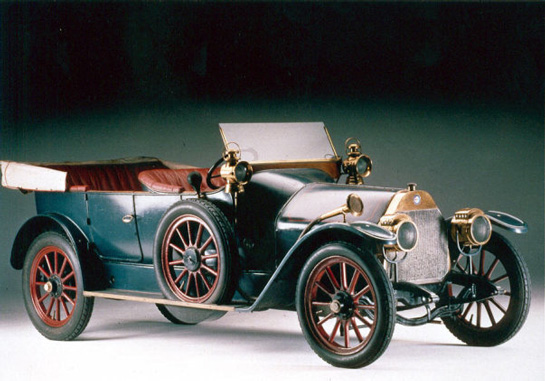
Merosi designed this 24 hp ALFA in 1909 and the model continued to be built until 1920, with a total of 680 cars of this type. Photo courtesy of the Alfa Romeo Museum.
A few years later Merosi was in Milan in charge of the technical department of the Bianchi company, whose well-engineered cars enjoyed a fine reputation. But in 1909 Merosi had the opportunity to join the newly established A.L.F.A. company that had taken over the assets of the Italiana Darracq concern at Portello in Milan. A.L.F.A. stood for the Societa Anonima Lombarda Fabbrica Automobili (the Lombardy Car Manufacturing Company) and the new organization hoped to succeed where its predecessor had failed, by developing a series of cars more suited to Italian conditions compared with the under-powered French Darracq designs that were more at home in the city.
Merosi designed a successful range of four cylinder machines including the 24 HP model that established a good reputation for the new firm in the years leading up to the First World War. Unfortunately Italy entered the conflict in 1915 and car manufacturing had to make way for munitions production.
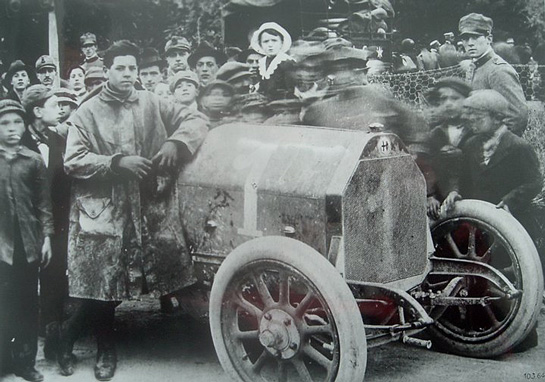
Giulio Ramponi next to the Merosi 40-60 HP Alfa Romeo in 1919 at the Parma-Berceto races. The 6 liter OHV design was capable of producing over 80 hp. The more famous 20-30 was a four cylinder 4.2 liter car. Photo courtesy of the Alfa Romeo Museum.
In 1918 the war finally came to an end, and the company was keen to resume car production at Portello. Several examples of Merosi’s pre-war designs were produced in 1920, now under the Alfa Romeo name, but Romeo was already looking ahead to a new era and Merosi soon returned to Milan to begin work on a new series of cars, despite having left the company a few months earlier, apparently due to a dispute over unpaid remuneration dating back to the financial chaos at the beginning of the war.
With modified examples of the pre-war range now in production such as the 6 liter 40-60 HP, Alfa Romeo also developed the ES Sport 20/30, a purpose-built sports model available with very stark bodywork and a tuned engine producing 67bhp at 2600rpm compared with the standard car’s 49bhp. Developed at the instigation of an Alfa Romeo agent called Antonio Ascari, who had motor sport ambitions, the ES Sport 20/30 was run in competition by the works team, as well as by private owners, and gained some good results in Italian events including class success on the Targa Florio.
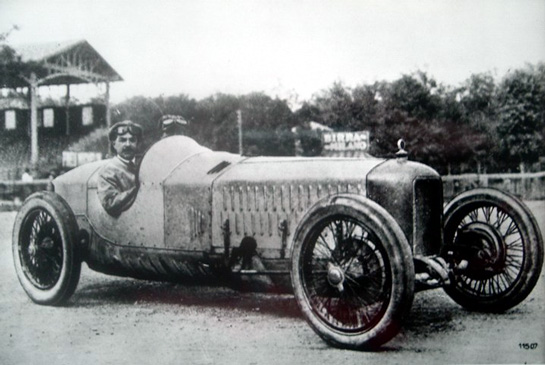
In addition to designing production engines with L Heads and Overhead valves, Merosi also was responsible for the 1914 four cylinder DOHC Grand Prix car and the P1, a 2 liter six cylinder DOHC. Ugo Sivocci, seen above in the P1, was killed in the car in 1923 and it was retired, to be replaced by Jano’s straight eight P2.
Despite this the new RL series was introduced to the public in October 1921 and was available in a choice of two specifications, the RLN (N for Normale) and RLS (S for Sport), aimed at different sections of the quality car market. In Great Britain the cars were known as the 21/70 and 22/90 hp (for taxation purposes the first number was the official horsepower rating — based on the diameter of the pistons and the number of cylinders — the second was the manufacturers rating, although this often seems to have been exaggerated!).
The RL Normale was a touring car with a longer chassis allowing more room in the rear seats and an engine in a lower state of tune; the RL Sport was aimed at the sporting owner-driver, the wheelbase, at 10’ 3” (3140mm), a foot shorter that the tamer RLN (3440mm), and usually fitted with lighter bodywork. The engine was in a higher state of tune and also of slightly greater capacity. Outwardly the main distinguishing feature was the radiator — the RLN’s was flat, whereas the RLS had a pointed radiator similar to that of the contemporary Mercedes.
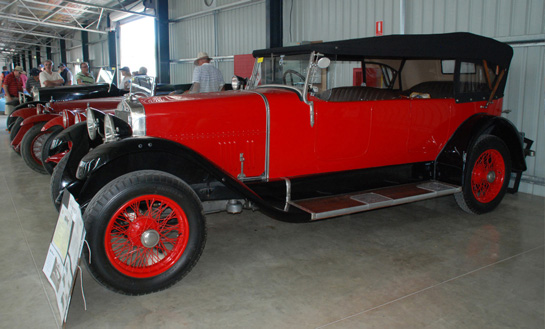
Vince Johnson in Australia photographed this superb RLN Alfa Romeo. The 3 liter six produced 56 hp and was built from 1921 to 1927. Note the flat radiator. The RLSS was a Super Sport version of the RL and RLN.
The RLN had a six cylinder 2916cc engine with push-rod operated overhead valves. Using a single up-draught carburettor, the engine produced 56bhp at 3200rpm which allowed a maximum speed of around 70mph, whereas the RLS had a capacity of 2994cc, a more sporting camshaft, and twin carburettors by Solex or Zenith, which helped to raise the power to 71bhp at 3500rpm and the top speed to over 75mph. At first both series had rear brakes only, but front wheel brakes were fitted to all cars from September 1923 onwards.
Part II focuses on the RLSS and RLTF cars.
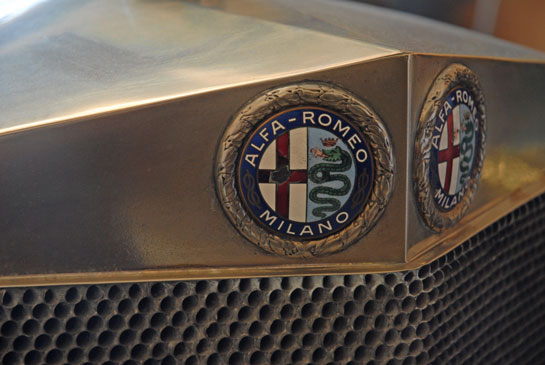
Its nice to see an article on Merosi and his often overlooked contribution to the Alfa Romeo legend. Thank you!.